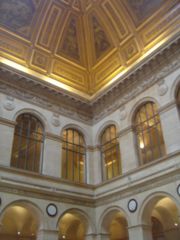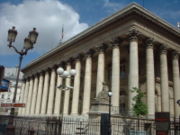巴黎证券交易所
出自 MBA智库百科(https://wiki.mbalib.com/)
巴黎证券交易所(Paris Bourse/Paris Stock Exchange)
目录 |
巴黎证券交易所是法国最大的证券交易所,1724年正式建立,其经纪人由法国财政经济部指定,共有99人,其中巴黎71人,外省28人。证券经纪人的工作是接受客户买卖证券的委托,掌握买卖双方供求数量和要求的价格幅度,代客户进行买卖,从中收取佣金。
巴黎证券交易所内的证券价格由供求关系决定,官方牌价由交易所业务委员会听取经纪人同业公会的意见后公布。
法国从1961年开始,所有交易所实行“单一价格”。巴黎证券交易所发行全国性、国际性和外国证券,7家外省交易所经营地区证券买卖、并划分了各自的管辖区,但有时一种证券也同时在几个交易所买卖,标价统一。巴黎所买卖的证券,在官方牌价表上约有经济部门的1300个发行者,其中180多个来自外国。交易所的客户是证券持有者,除其本国法人如保险公司、退休金金库、存款及信托金库、可变资本投资公司、共同投资基金、银行、工业发展局和地区发展公司外,外国人(含外国企业)也持有各种证券。交易所在进行现货交易的同时也进行期货交易,期货交易的绝大部分在巴黎所进行。此外,不属于官方牌价表上的一切证券可以进行场外交易,但只能是即期买卖。
巴黎证券交易所的组织机构包括:
- (1)经纪人公会,由法国7家交易所的经纪人组成,属私人机构;
- (2)交易所业务委员会,1967年成立,系国家机构,主席由部长理事会任命,另加国库司的一个成员作为政府特派员参加该委员会。其职责是对有关重大问题(如建立或撤销交易所、修改现行法律章程)提出意见和建议,对一些技术性的问题作出决定。如确定期货交易所需要的保证金数额、决定佣金费率;在征求同业公会的意见后,对准许证券列入官方牌价表或注销上市的证券作出最后决定;向共和国总统递交日报和年报。巴黎证券交易所在世界各大交易所中,次于纽约、东京和伦敦,名列第四。
巴黎证券交易所是法国唯一的全国性的证券交易所。长期以来,巴黎证交所,一直以债券交易为主。不过80年代以来,法国实行了一系列金融改革政策措施以后,巴黎证交所的股票和债券发行量大大增加。
巴黎证券交易所以往一直由法国财政部直接管理,1967年以后改由证券交易业务委员会管理。该委员会作为国家机构,对交易所的交易活动进行监督,并对重大问题作出决定。
1986年,巴黎证交所开办了金融期货市场,它以债券为主要对象,并从事长期和短期的所有金融商品的交易。自1991年5月起,巴黎证券市场的结算交割作业全部纳入了电脑系统,交易效率得到了很大的提高。
Historically, stock trading activities have been located in several spots of the Parisian geography, including the rue Quincampoix, the rue Vivienne (near the Palais Royal), or the back of the Opéra Garnier (the Paris opera house). In the early nineteenth century, the Paris Bourse's activities found a stable location at the Palais Brongniart, or Palais de la Bourse (the building is due to architect Alexandre-Théodore Brongniart).
历史上,证券交易活动位于巴黎地区若干地点,包括, Quincampoix大街、Vivienne大街(临近皇家花园)抑或是Garnier剧场。十九世纪初,巴黎证券交易所的活动有了固定场所:Brongniart宫殿,或者叫证券宫(建筑命名源于建筑师亚历山大西奥多Brongniart)
From the second half of the nineteenth century, official stock markets in Paris were operated by the Compagnie des agents de change, directed by the elected members of a stockbrokers' syndical council. The number of participants in the processes of the formation of prices and of exchange in each of the different trading areas of the Bourse was limited. In the case of the agents de change (the official stockbrokers at the Paris Bourse), there were around 60. An agent de change had to be a French citizen, be nominated by a former agent or his estate, be approved by the Minister of Finance, and was appointed by decree of the President of the Republic. Officially, the agents de change could not trade for their own account nor therefore even be a counterpart to someone who wanted to buy or sell securities with their aid; they were strictly brokers, that is, intermediaries. In the financial literature, the Paris Bourse is hence referred to as "order-driven market", as oppose to "quote-driven markets" or "dealer markets", where price-setting is handled by a dealer or market-maker. In Paris, only agents de change could receive a commission, at a rate fixed by law, for acting as an intermediary.
自十九世纪下半叶开始,在股票经纪人联合会代表的监督下,巴黎的官方证券交易所由股票经公司经营。证券交易所不同交易区域里,数量有限的参与者促成了交易和交易的价格。至于股票经纪人(指巴黎交易所的官方经纪人),其数量在60人左右。一个股票经纪人,应该为法国公民,由一位前经纪人提名,经财政部长批准后,由总统书面任命。明确规定,经纪人不能用自己的帐户做交易,也还能成为在其帮助下有购买或出售证券意向者的交易对方;他们作为严格意义上的中介者。因此,在金融著作中,巴黎证券交易所被称之为“指令驱动的市场”,与此相对应的是“报价驱动的市场”又称“交易员市场”,后者的定价由交易员或做市商掌握。在巴黎,只有经纪人可以通过中介活动收取法定比例的佣金。
However, parallel arrangements were usual in order to favor some clients' quote. Moreover, until approximately the middle of the twentieth century, a parallel market known as "La Coulisse" was in operation.
Until the late 1980s, this market was operating as an open outcry exchange, with the "agents de change" (the Parisian stockbrokers) meeting in the exchange floor of the Palais Brongniart. In 1986, the Paris Bourse started implementing an electronic trading system known as CATS (Computer Assisted Trading System), renamed CAC (Cotation Assistée en Continu) for the Parisian version. By 1989, quotation was fully automated. The Palais Brongniart was then hosting the French financial derivatives exchanges MATIF and MONEP, until full automation of these in 1998. In the late 1990s, the Paris Bourse launched the Euronext initiative, which consisted in the alliance of several European stock exchanges.
On the history of the Paris Bourse:
Lehmann, P.-J. 1991 La Bourse de Paris, Paris: Dunod.
Lehmann, P.-J. 1997 Histoire de la Bourse de Paris, Paris: PUF.
Muniesa, F. 2005 "Contenir le marché: la transition de la criée à la cotation électronique à la Bourse de Paris", Sociologie du Travail 47(4): 485-501.
Walker, D. A. 2001 "A factual account of the functioning of the nineteenth-century Paris Bourse", European Journal of the History of Economic Thought 8(2): 186-207.
On the structure of the Paris Bourse:
Biais, B., Foucault, T. and Hillion, P. 1997 Microstructure des marchés financiers: institutions, modèles et tests empiriques, Paris: PUF.
Hamon, J. 1995 Marché d'actions: architecture et microstructure, Paris: Economica.
Hamon, J. and Jacquillat, B. 1992 Le marché français des actions: études empiriques 1977-1991, Paris: PUF.









